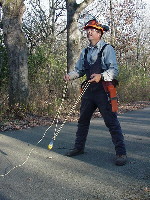| Chapter 8. Formulating the Felling
Plan. Before you undertake a task, what do you normally do? Do you think through the task or just dive right in without any forethought on what you need to do to accomplish the task in an efficient, effective, and safe manner? Planning is important in everything we do, and it is the key element in the safe use of a chain saw. Formulating a felling plan before starting the saw provides the operator with an opportunity to:
In timber harvesting, a good felling plan provides consistency in the execution of the tasks at hand, which leads to improved efficiency and safety for the chain saw operator. In my training programs, I devote a considerable time to understanding the elements of a good tree felling plan. For the casual woodcutter or the professional, this is where the ‘rubber meets the road’. Again, I use a simple five step plan that is easy to remember, but one that covers all the critical elements necessary to get the tree safely on the ground in a desired location. Each of these steps is covered in detail below. Prior to developing the felling plan, the chain saw operator must determine the location of the tree’s landing zone. Frequently the landing zone may be in a direction that is different from the direction the tree would naturally fall due to its weighted lean. The chain saw operator must determine if the tree will ‘fit’ into the desired landing zone, and if it is possible to direct the tree’s fall into this zone using the directional felling techniques. If the selected tree is growing in a woodland, its crown must have sufficient clearance from the surrounding trees to allow it to fall into the landing zone. If there is not enough room, there is a good chance the tree’s crown will lodge or ‘hang up’ in one of the surrounding trees producing a very dangerous situation that can be difficult to resolve. Similarly, if the tree to be harvested is growing in a residential setting, the operator must make sure the tree’s crown will clear nearby buildings, fences, and overhead power lines as it falls into the desired landing zone. Every tree leans. The key to being able to place the tree in the desired landing zone is to understand how lean affects where the tree would fall naturally and whether or not certain felling techniques can be used to overcome the influence of the its natural lean. Often lean can be deceiving. For example, if you focus strictly on the tree’s trunk, it may appear to have definite lean to one side when actually the tree leans in the opposite direction due to the weight of its branches in the crown. In fact, every tree leans 360 different directions depending on where you view it. Lean is discussed in Step 2 below. In a situation where a tree’s lean will not permit it to fall into the desired landing zone, it will be necessary to change the landing zone. If this is not possible, other means of removal, such as having an arborist remove the tree from the top down, will need to be employed. Landing zone adjustments generally do not present major problems in a forest, but present real problems when removing trees in residential settings. The Felling Plan - Step 1. Identify Potential Hazards. Too often, chain saw users begin cutting without assessing the potential hazards that surround them. There are frequently many dangers in and around the cutting zone which, if not recognized, could lead to potential injury or death for the chain saw operator. You can eliminate many hazards before you make the first cut on the tree. Other hazards you may not be able to do anything about, but recognizing they exist alerts you to their potential danger.
You will be working at the base of the tree, so look up into the tree’s crown and identify attached dead limbs and any hanging branches that could possibly fall on you as the tree begins to fall. Are there any vines growing in the crown of the tree and down the trunk that need to be severed? Do the vines stretch from your tree’s crown to the crowns of neighboring trees? Do you need to severe vines growing from other tree’s into your tree’s crown? Can these vines possibly keep your tree from falling or might they create a problem in directing the tree to the landing zone you have selected?
|
|||||||
|
|||||||
|
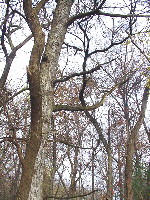
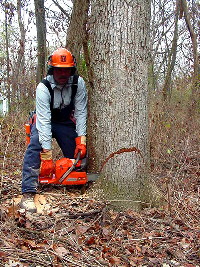
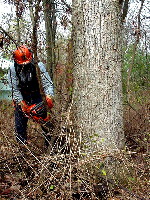
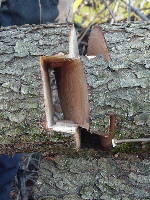
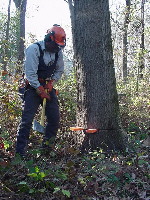

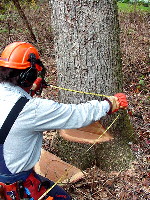 Notching
Notching
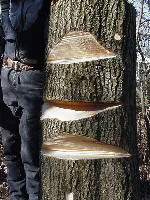 Hinging
Hinging
 Special Techniques
Special Techniques 